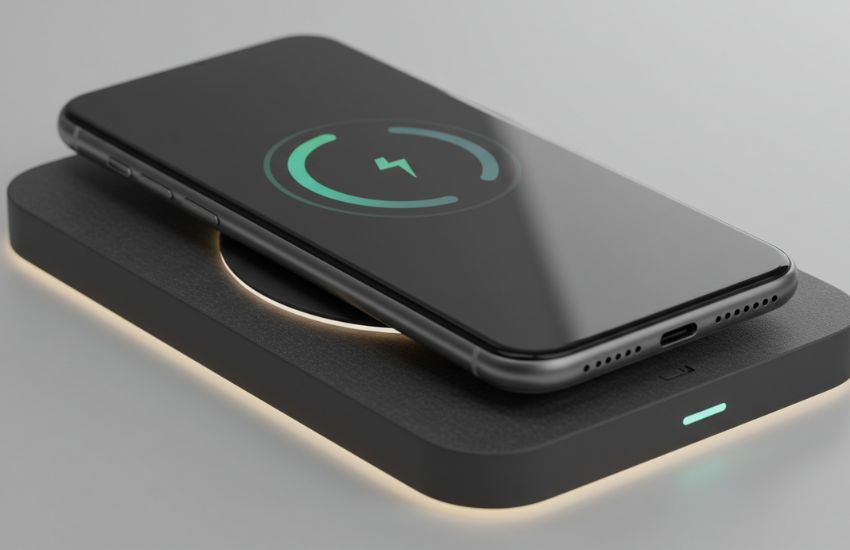For many smartphone owners, a wireless charger is more of a convenience to own. However, the debate on whether wireless charging damages batteries prevails. This article will explain the evidence supporting wireless power transfer and make common-sense recommendations.
The Mechanism of Wireless Charging
Inductive systems differ from traditional cable chargers, which deliver current through a port on your phone, in that they use electromagnetic fields to induce an alternating current that induces current into the secondary coil embedded inside the device. In other words, the primary coil in the charger makes a moving magnetic field that pushes current into the secondary coil embedded in the device.
That current then feeds the battery-management circuitry, topping up energy without physical connectors. Because of this contactless exchange, some energy dissipates as heat. Manufacturers design wireless pads to operate at moderate voltages and currents, far gentler than rapid wired chargers.
Yet, critics ask whether repeated exposure to that slight inefficiency accelerates battery wear.
Heat, Charge Cycles, and Battery Wear
Battery degradation is driven primarily by two factors: the number of full charge cycles and the cell’s operating temperature. Every time you recharge from 0% to 100%, you use one full cycle.
Partial charges count proportionally; charging from 50% to 80% consumes 0.3 of a cycle. Heat intensifies chemical reactions inside lithium cells, speeding up capacity loss. When evaluating whether a wireless charger is bad for a battery, heat is the chief culprit.
Wireless pads often produce more warmth than equivalent wired setups. However, a well-engineered charger with temperature control can mitigate most of that extra heat. In practice, you’ll see a modest rise in surface temperature, typically between 2 °C and 5°C above ambient, when using a certified pad.
Examining the Evidence
Several independent laboratory tests compare cable versus inductive charging. On average, the difference in battery capacity retention over 500 cycles is within a few percentage points. In other words, if a wired regime preserves 90% capacity after 500 cycles, an optimized wireless approach might yield 88% to 89%.
That small gap translates to only a few weeks of extra battery life over two years. The key takeaway: wireless charging and battery health can coexist harmoniously, provided you use quality equipment.
Cheap knockoff pads lacking thermal safeguards or consistent output might push your battery closer to its thermal limits, accelerating wear. But reputable brands adhere to industry specifications certification, in particular ensuring safe voltage regulation and temperature monitoring.
Balancing Convenience and Longevity
If you worry about wireless charging battery life, consider these practical tips:
- Choose Certified Chargers: Opt for Qi-certified or manufacturer-approved pads. They include essential safety features like overcurrent protection, foreign-object detection, and thermal cutoffs.
- Maintain Moderate Charge Levels: Lithium batteries fare best when they stay between 20% and 80% charge. Frequent top-ups on a wireless dock at your desk can help avoid deep discharges and full charges.
- Mind the Heat: Remove bulky cases or metal attachments that trap heat. If your phone warms excessively, pause charging until it cools.
- Use Overnight Mode: Sparingly Some phones pause charging at 80% and only finish overnight. While clever, this timing algorithm can stress the battery if it remains at high voltage for extended periods.
- Alternate with Wired Charging: Rotate between wireless and wired methods. This prevents constant exposure to a single charging characteristic and helps distribute stress evenly across battery cycles.
These recommendations will help reduce wireless charging on battery life. Think of wireless power as more of a complement than a substitute, particularly for the more essential times of charging or when you really need that quick boost.
Debunking Common Myths
- Myth: Wireless charging always generates excessive heat.
- Reality: Quality pads limit temperature rise to safe levels.
A 5°C increase is negligible compared to outdoor summer temperatures.
- Myth: Charging wirelessly depletes more cycles.
- Reality: Partial top-ups count as fractional cycles.
Regular wireless top-offs can actually reduce full-cycle stress.
- Myth: Wireless transfers underperform to the point of battery damage.
- Reality: Efficiency rates hover around 70–80%, and most losses appear as minor heat.
With modern thermal controls, damage is minimal over normal device lifespans.
Conclusion:
So, is wireless charging bad for your battery? For most users, the answer is no. It helps you select reliable chargers, manage heat, and avoid extreme charge patterns. Concerns about the impact of wireless charging on battery health stem mainly from low-quality accessories rather than the technology itself. When executed with proper safeguards, wireless charging and battery health coexist with minimal compromise.
